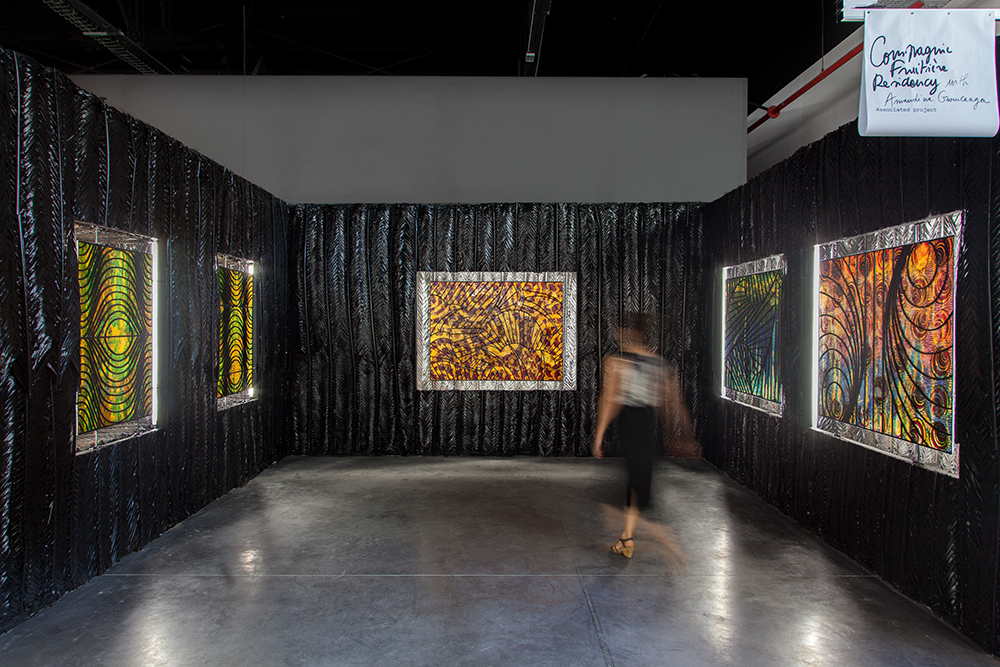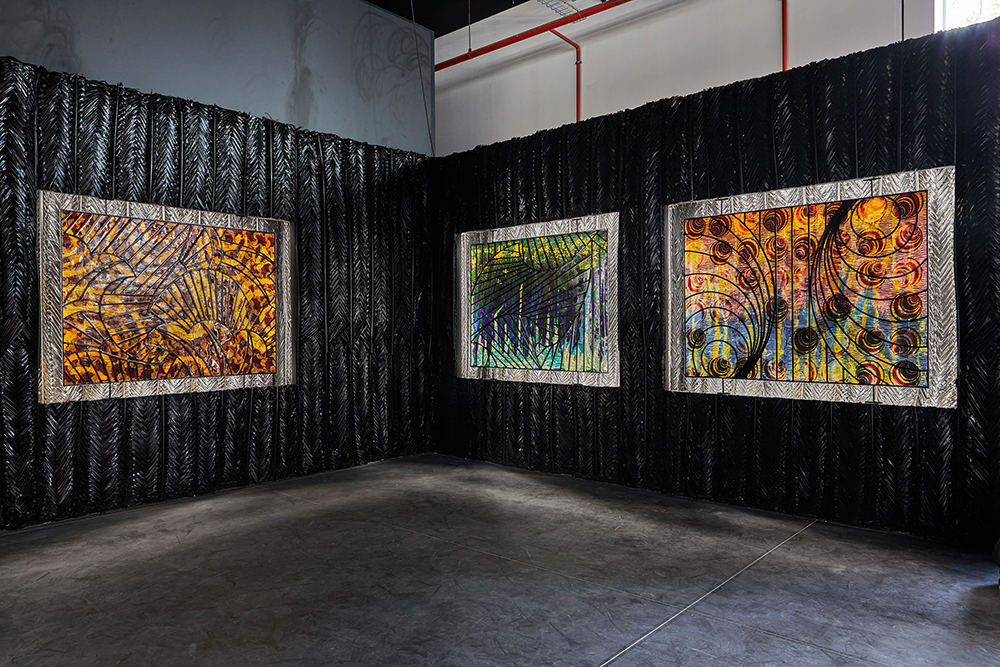-

Lady Rosebud, Compagnie Fruitière International Residence Project by Fraeme in Ivory Coast
(from left to right) The Eye of My Rival I, II, Wedding flower, Chérie don’t turn your back on me, Génito, 2019, steel ironwork, wax, resin, braided palm leaves, 120x160cm each Exhibition view, solo show installation during the ART-O-RAMA art fairLady Rosebud, Projet de Résidence internationale de la Compagnie Fruitière par Fraeme en Côte d’Ivoire
(de gauche à droite) L'oeil de ma rivale I, II, Fleur de mariage, Chérie ne me tourne pas le dos, Génito, 2019, ferronnerie acier, wax, résine, feuilles de palmiers tressées, 120x160cm chaque Vue d’exposition, installation solo show lors de la foire ART-O-RAMA -
-
Solo Show, ART-O-RAMA 2019
Lady Rosebud -Projet de résidence internationale de la Compagnie Fruitière en Côte d'Ivoire
Porter une « fleur de mariage », surveiller « l’œil de ma rivale », apparaître en « Génito », dire « chérie ne me tourne pas le dos », sont autant de messages envoyés aux proches, à un mari, à la société en général dès lors que l’on souhaite se marier, quand on éprouve les affres de la jalousie, si l’on s’affirme comme force de la nature et géniteur fantasmé ou encore lorsque l’on réclame de l’amour et de l’attention.
Ces mots, ici couchés sur le papier, sont les significations données à des motifs dupliqués sur les waxs. à chaque tex- tile son dessin sui generis porteur de message. Arborer telle étoffe plutôt que telle autre est une manière d’affirmer son état d’esprit, son envie, son urgence et sa culture.
La communication prend parfois des chemins singuliers et Amandine Guruceaga, dès les prémices d’une œuvre en train de se faire, relève, dans la singularité des chroniques relatant la puissance du wax, d’abord britannique, puis lar- gement néerlandais alors que commercialisé en Afrique Subsaharienne, le creuset d’une histoire des hommes et de leurs relations de pouvoir.
Intitulé Lady Rosebud, le projet protéiforme d’Amandine Guruceaga est né de sa résidence passée en Côte d’Ivoire, au cœur du domaine de Tiassalé, le titre étant une citation au bateau convoyeur de marchandises qui relie le continent africain à l’Europe.
L’artiste associe les tissus, messagers de l’intime, aux grilles nommées fort justement les « anti-vols », qui sont apparus sur les façades des nouvelles villes coloniales d’Afrique afin d’en protéger les occupants tout en affirmant leur richesse,
en contraste aux architectures vernaculaires largement ou- vertes à la communauté.
L’assemblage du métal au tissu, du motif apparu d’abord par l’effort des soudeurs, les structures métalliques affichant fièrement leurs missives, lesquelles, couplées au wax lui- même, présentent leur message comme altéré, produisant une forme de vitrail hybridé, un mixage de matériaux en forme de bas-relief, une alchimie ajourée, un objet hésitant entre son utilité et sa préciosité, une anomalie.Lady Rosebud, série d’œuvres ici présentées, s’approprie une forme modifiée d’habitat traditionnel, où les papeaux (papo) qui leur sont empruntés emportent le visiteur au cœur du vernaculaire. « L’histoire est inscrite dans la ma- tière » nous dit Amandine Guruceaga, et Lady Rosebud de nous raconter celle de sa résidence, du travail réalisé en collaboration avec les mécaniciens du domaine de Tiassalé, de cette rencontre avec un territoire plus vaste encore que constitue le paysage de Côte d’Ivoire, habité par des femmes et des hommes, incarné dans une culture puissante et hé- ritière des soubressauts du passé. L’échange a eu lieu, une alchimie, qui ne dénature en rien mais plutôt déplace, s’est opérée par la lente élaboration des formes et des matières, elle est ainsi fidèle à sa pratique artistique qui traverse les frontières autant plastiques que géographiques.
Véronique Collard Bovy
-
